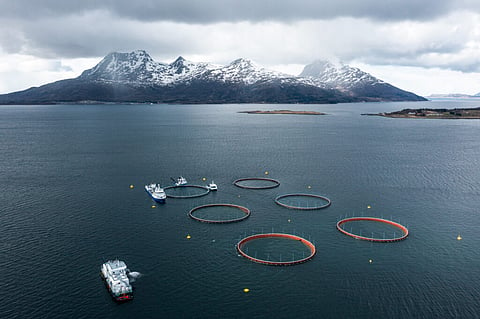

Norcod's Labukta site, in the municipality of Nesna, Nordland county, in northern Norway.
Photo: Hans Petter Sørensen / ScaleAQ.
Approximately 27,500 farmed cod escaped from the Norcod facility in Nesna, Nordland county, northern Norway, at the end of November. This has been reported by the Norwegian Directorate of Fisheries (Fiskeridirektoratet, Fdir, in its Norwegian name and acronym) which said the figure was confirmed after the fish in the affected cage were harvested.
Likewise, the Directorate also said that, based on a recent harvest count too, another Norwegian cod producer, Ode, has reported that approximately 3,000 fish escaped from its facility in Korsnesfjorden, near Kristiansund, in August.
In late November, Norwegian cod farming company Norcod reported an escape after an incident at one of its Nordland facilities, namely at its Labukta location in the municipality of Nesna, following damage to one of the nets was discovered.
The company immediately put its emergency procedures into action and so the damaged pen was sealed, recapture nets were deployed, and emergency fishermen were mobilized to catch the escaped cod, which at the time of the incident had an average weight of just under 3 kg.
Later, on December 31, Norcod said that recapture efforts were still ongoing and that, so far, 4,530 fish had been captured and were likely to have come from its site. In addition, the cod producer decided to harvest the entire cage to get a full picture of the magnitude of the escape and estimated then that the escaped fish numbered 22,979.
In addition, it also reported that in January 2025 it would conduct an inspection and investigation of the network in collaboration with representatives of the Norwegian Directorate of Fisheries and the supplier ScaleAQ to determine the cause of the opening.
"This is a serious incident. Until a thorough investigation of the net is completed in January, we do not wish to speculate on the cause. Norcod has a zero-escape vision and is leaving no stone unturned to learn from this and prevent such incidents from occurring again," Chris Guldberg, COO and spokesperson for Norcod, said then.
Fdir - which has an inspection file open in relation to the incident - has now confirmed that, once the fish in the affected cage were harvested, the number of escaped farmed cod amounts to approximately 27,500 fish, and that recapture efforts are continuing around the facility. So far, approximately 5,100 farmed cod have been recaptured.
Only a few days before this confirmation, the Norwegian Directorate of Fisheries also reported that last summer's cod escape from Ode's site in Korsnesfjorden near Kristiansund had been clarified.
At the end of August 2024, the Directorate received a report of a possible escape at Ode's site, Aukan, in Aure Municipality, in Møre og Romsdal province, Norway. Damage had been discovered in one of the nets containing fish with an average weight of just over 2 kg at the time of the escape.
After the incident, Ode deployed nets near the facility but was unable to recapture any fish with them. However, the company has received 965 farmed cod caught by a commercial fisherman and the Directorate of Fisheries has also received several advisories about catches of escaped farmed cod in the area.
Thus, Fdir has conducted an inspection of the incident and required the company to count the remaining fish in the cage before February 1, 2025. As in the case of Norcod, the count which results are now available was conducted in connection with the harvest of the affected cage.
After carrying it out, the Norwegian cod producer - which has started the year with the announcement of a new site approval, the seventh - has reported that, as said above, approximately 3,000 farmed cod escaped from its facility.
Escapes are, together with control over maturation, the Norwegian Directorate of Fisheries' main areas of control and concern regarding cod farming at sea. "Spawning in pens can result in farmed cod escaping into the fjords, which can then spawn with wild cod and lead to genetic changes in cod populations. This is an undesirable impact," Fisheries Director Frank Bakke-Jensen said last fall.
